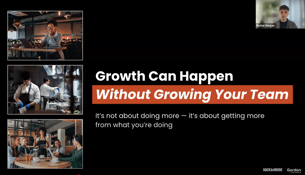Updated August 28, 2025
You’ve nailed the recipes, picked the perfect location, and hired a solid team. Now comes the part that makes a lot of first-time operators pause: marketing. How do you actually get foot traffic?
Here’s the thing. Marketing doesn’t have to mean big budgets or complicated campaigns. It’s really just about getting the word out in a way that feels authentic to you. With the right tools (and a little creativity), you can start building buzz before your doors even open.
In this guide, we’re breaking down the most effective and manageable ways to market your restaurant from day one. Let’s make sure your community knows exactly where to find their new favorite spot.
Before You Begin: Set Realistic Goals
Before you dive into promotions and hashtags, take a breath. The best marketing plans start with clear, manageable goals. Not every channel is right for every restaurant, and you don’t have to do everything at once.
Instead, pick one or two places to focus your energy — maybe Instagram if your dishes are photo-worthy, or email if you want to build a list of loyal customers. Define what success looks like to you. Is it 500 Instagram followers in your first three months? A steady stream of five-star reviews? Ten newsletter signups a week?
Marketing is a long game, and starting with realistic, specific goals will keep you focused, motivated, and way less stressed.
Top 4 Restaurant Marketing Strategies To Get You Started
There’s a lot to juggle when launching a new restaurant. While you’re perfecting the menu and securing an all-star staff, make sure you don’t forget to get the word out.
Boost Your Restaurant’s Online Presence With Social Media
It seems almost too obvious to say, but we’re going to say it anyway just in case: create social media accounts on all the major platforms, then — and this is the important part — use them! (If you’ve muttered “yeah, duh,” feel free to skip ahead to the next section.)
-
New menu items that are going to be coming out soon
-
Behind-the-scenes work, like ingredient prep, sourcing trips, and meetings with key vendors
- Restaurant promotions such as giveaways (everyone loves a free meal) or limited-time special offers
-
Regular or new customers, and beloved employees (with their permission, of course!)
Many of your followers on these platforms will be potential customers, and demonstrating the unique culture and community of your business through social media marketing can help you stand out against the competition when they’re thinking about where to eat next. To help make it easier, these platforms also let you target audiences within a few miles of your restaurant, perfect for lunchtime promos or weekend events.
User-Generated Restaurant Content To Grow Your Restaurant’s Brand Awareness
User-generated content (or as it's often shorthanded, “UGC”) is just a fancy way of saying photos, videos, online reviews, and more that your guests and followers produce about your restaurant. The content can be in the form of a positive review on Yelp or someone sharing an Instagram post of their delicious meal.
Once it’s out in the open, you can use these user-generated posts to market your restaurant. It can be as simple as reposting a positive comment on your Instagram story or adding a testimonial section to your website.
Studies show that 92 percent of consumers trust word-of-mouth referrals from people they know and trust. Integrating UGC into your marketing not only gives a vote of confidence but allows you to connect with your customer base in a new way outside your restaurant.
Restaurant Email Campaigns That Keep Guests Coming Back
Email marketing campaigns are one of those behind-the-scenes tools that can quietly do a lot of heavy lifting. A few engaged subscribers can turn into full tables and steady takeout orders. Keep your emails friendly and on-brand, just as if you’re having a conversation with your regulars.
Whether it’s an option on your restaurant's website or when people are paying their bill, you should have a way for guests to sign up for your email list. These lists naturally build a pool of customers who are already familiar with and interested in your restaurant.


Subscribe to Our Monthly Marketing Newsletter
Get proven strategies and tools to attract new customers, boost engagement, and grow your brand.
Be sure to schedule a regular time to send an email newsletter out to your subscribers. It can be weekly, monthly, or whatever other time frame fits your workflow, but the key is to be consistent.
You can share what’s new with your restaurant, such as updated menu items, special events, seasonal hours, or even new e-commerce options if you sell merch or gift cards. You can also sweeten the deal and provide incentives like promo codes or special deals to encourage people to join.
Partnered Events With Other Local Businesses
Two mouths are better than one, and that’s what makes partnership events so powerful. When you partner with like-minded organizations and vendors, you can reach a wider demographic through cross-promotion.
Think about having a tap takeover night with your favorite brewery, a special winemaker’s dinner, or even a regular trivia night. Just find partners that will champion the event alongside you, marketing to their network through social media, email, signage, and more.
Other Restaurant Marketing Ideas That Work
Besides the big four, other smaller yet effective restaurant marketing channels can make a huge difference. Here are a few more ideas to help get (and keep) guests through the door:
- Set up your Google business profile: This is one of the easiest ways to boost your visibility on Google search and Google Maps. Keep your hours, online menu, and photos up to date so guests can find you fast, and make sure your location appears when someone nearby searches for “restaurants near me.”
- Focus on local SEO: Make sure your website includes your city or neighborhood name so search engines know where you are, and locals can find you when they’re hungry. Want an extra boost? Try running Google Ads targeted to your area to show up in search results right when people are looking up the best restaurants near them.
- Use SMS marketing for quick hits: Got a last-minute happy hour or running a half-price appetizer special? Text your subscribers with real-time updates or exclusive offers.
- Build a solid SEO foundation: Your website should be easy to navigate, mobile-friendly, and filled with keywords people actually search for (like “best tacos in [your city]” or “best local restaurant”).
- Highlight your values: If you support local farms, reduce waste, or give back to the community — share it! Today’s diners love a restaurant with a mission.
- Offer referral perks: Give your repeat customers a reason to bring in friends with small rewards like a free appetizer or dessert for every new guest they refer.
- Simple loyalty programs: Whether it’s a digital punch card that gets them a free dessert after five visits or $10 off their next visit after 10 stamps, customer loyalty programs can work wonders. You can also surprise your regulars with special off-menu items or sneak peeks of seasonal dishes to keep things fresh and exciting.
First visits are great, but second, third, and tenth visits are even better, and retention should be a part of your marketing strategy from day one.
Common Restaurant Marketing Mistakes (and How To Avoid Them)
Even seasoned restaurant owners slip up when it comes to their marketing efforts. Here are a few common pitfalls to watch out for and how to dodge them:
- Trying to be everywhere at once: Focus on one or two platforms and do them well. Spreading yourself thin leads to burnout and bland content.
- Ignoring negative reviews: Every customer review is a chance to learn (and recover). Respond kindly, stay professional, and show you're listening.
- Relying only on stock photos: Authenticity matters. Share real shots of your food, your team, and your space, even if they’re not perfect.
- Not tracking what’s working: If you don’t measure it, you can’t improve it. Track metrics like follower growth, email clicks, and coupon redemptions to see what’s resonating.
Tools and Resources To Make Marketing Easier
You don’t need a big marketing team or need to use a whole bunch of marketing tactics to make a big impact. These simple marketing tools can help you save time, create great content, and stay organized:
- Free design tools: Canva and Unsplash offer easy ways to create eye-catching graphics and find high-quality images.
- Social media schedulers: Tools like SproutSocial and Hootsuite let you plan posts in advance so you can focus on running your kitchen.
- Email platforms: Mailchimp and Klayvio are beginner-friendly options to start building your list and staying in touch with customers.
- More support from Back of House: Check out our blog for guides, how-tos, and real-world tips to make your marketing life easier.
You’ve Got the Food — Now Let Back of House Help You Spread the Word
Marketing is a skill, not a superpower, and like any good recipe, it gets better the more you work at it. To make your life easier, Back of House is here with the resources and real-world guidance you need, from helping you spread the word about your grand opening to planning next month's promo.
Need hands-on help? Book a free call with our team to get personalized support in setting up your restaurant operations, including POS systems and food inventory management, as well as HR and staffing, such as training, hiring, and scheduling.





